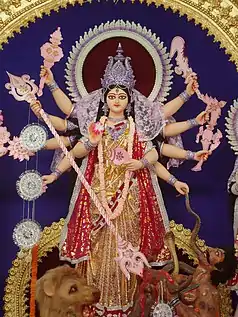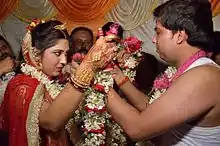Ethnic communities in Kolkata
Kolkata, India, is largely inhabited by the ethnic community of the native Bengali people (both Ghoti and Bangal origin) respectively. According to a report by the Indian Statistical Institute owned by the Government of India, the Kolkata city had a population of 4.5 million as of 2011 out of which the population of Bengali Hindus in Kolkata is 62% which comprised the majority of the city's population, whereas Marwaris, Biharis, Muslims together forming 34.4% of the population which comes under the category of large minorities. Other Various micro-minortiy communities of Kolkata include as far as concerned follows -: Sindhi people, Pathan people, Marathi people, Odia people, Gujarati people, Kashmiri people, Punjabi people, Nepalis, Telugus, Tamil, Anglo-Indian, Iraqis, Jewish, Armenian, Tibetan, Greek, Parsi, Chinese, and Iraqi people.

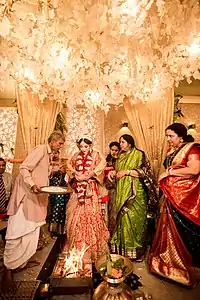
Linguistic groups in Kolkata city (2011)
Chinese
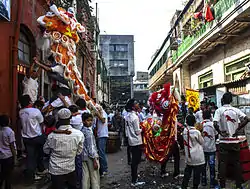

Chinatown (Bengali: চায়নাটাউন, কলকাতা) in the eastern part of the city of Kolkata is the only Chinatown in India.[1] Once home to 20,000 ethnic Chinese, its population dropped to around 2,000 as of 2009[2] as a result of multiple factors including repatriation and denial of Indian citizenship following the 1962 Sino-Indian War, and immigration to foreign countries for better economic opportunities.[3] The Chinese community traditionally worked in the local tanning industry and ran Chinese restaurants.[2][1]
Iraqis

Iraqis first arrived in Kolkata during late 19th century from Eastern Uttar Pradesh state of India.Today majority are in the leather work of the city. Most of them live in areas of Park Circus and Topsia. The present Iraqi population in Kolkata is estimated to be 10,000.
Jewish
Kolkata's Jews are mostly Baghdadi Jews who came to Kolkata to trade. At one point as strong as 6000, the community has dwindled to about 60 after the formation of Israel. Today there are only about 30 Jews left in Kolkata. The first recorded Jewish immigrant to Kolkata was Shalon Cohen in 1798 from Aleppo in present-day Syria. The most influential Jewish family in Kolkata was perhaps the father-son real estate magnates David Joseph Ezra and Elia David Ezra. They were behind such buildings as the Chowringhee Mansions, Esplanade Mansions and the synagogue Neveh Shalom.the family also were instrumental in the founding of the Jewish Girls School. Ezra Street in Kolkata is named after them. The community has five independent synagogues in Kolkata, including one in Chinatown, some of which are still active today. The Jewish confectioner Nahoum's in the New Market holds a special place in Kolkata confectionery. Founded in 1902, Nahoum's moved to its present location in the New Market in 1916. It is run today by the original owner's grandson, David Nahoum. A Jewish wedding in Kolkata after a gap of 50 years in the 1990s received a lot of media attention.[4] After the establishment of Israel, many Kolkatan Jews left to live in Israel and the size of the Jewish community had a severe decrease.[5]
Armenian
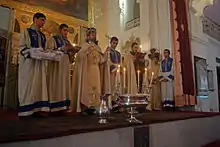
The Armenians followed the land route through Bactria to trade with India from ancient times. They were known as the "Merchant Princes of India", and some settled in Emperor Akbar's court. Some finally settled in Serampore and Kolkata, supposedly under the invitation of Job Charnock.
Among notable Armenians, Sir Apcar Alexander Apcar, a prominent businessman, was the head of the Bengal Chamber of Commerce and Industry. The size of the Armenian community can be testified by the five Armenian cemeteries in Kolkata, including the one adjunct to the Chapel of Holy Trinity in Tangra and an Armenian church. A gift of Rs. 8000 by Asvatoor Mooradkhan helped found the Armenian College in 1821. Armenian College has been instrumental in pioneering the game of rugby on the Maidan turf.
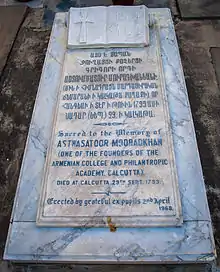
The Armenians settled in a block close to Free School Street, which even to this day is called Armani-para ("the neighbourhood of the Armenians"). They have mostly assimilated into the Indian population, and the community has now been reduced to a handful of houses.
Tibetan
The Tibetans were initially annual winter visitors to Kolkata who, along with the Bhutias, vended woollens. Post 1951, Kolkata became home to quite a few Tibetans who used the porous Sikkim-Tibet border to get to Kolkata. Winter sees large numbers of Tibetans set up winter garment streetside shops in the area around Wellington Square. The Tibetan community has also contributed to a large number of Tibetan restaurants serving ethnic Tibetan cuisine. Tibetan medicine is well accepted in Kolkata as alternative therapy to terminal illnesses.
Afghans
Kolkata was a popular desination for Afghan (including Pathan) businessmen from Afghanistan in the 19th century, vending spices and fruits. They are locally known as the Kabuliwala, named after the 1892 story which tells the story of a migrant from Kabul to Kolkata, and are also nicknamed as the Khans like elsewhere in India.[6]
Greek
The Greeks emigrated to India after the Ottoman and Turkish invasions in the 16th century. Kolkata had a sizeable Greek community, mostly a close-knit clan of noble families from the Greek island of Chios, pursuing trade with the British. The firm of Ralli Brothers is perhaps the most common Greek name in Kolkata; the Rallis sold their firm in the 1960s after Indian independence and moved away, like most of the Greek community. The firm is now known as Ralli India, under the Tata Group of companies. The Greek community was centred on Amratollah Street around the Greek Church of the Transfiguration (built in 1782). The most famous Greek to hail from Kolkata possibly was the gifted violinist Marie Nicachi who embarked on a European tour in 1910 and played at the courts of Emperor Franz Josef of Austria and Tsar Nicholas II of Russia. She settled in her familial home of Corfu after World War I. The Greek contribution to the city will be remembered by the pioneering social work at the Greek Orthodox Church and the Panioty Fountain in the Maidan—named after Demetrius Panioty, personal secretary to the "friend of India," Lord Ripon.
See also
References
- "Calcutta's Chinatown facing extinction over new rule". Taipei Times. Taipei, Taiwan. 31 July 2004. Retrieved 22 October 2018.
- Banerjee, Himadri; Gupta, Nilanjana; Mukherjee, Sipra, eds. (2009). Calcutta mosaic: essays and interviews on the minority communities of Calcutta. New Delhi: Anthem Press. pp. 9–10. ISBN 978-81-905835-5-8. Retrieved 29 January 2012.
- Thampi, Madhavi, ed. (2005). India and China in the colonial world|. New Delhi: Social Science Press. pp. 60–64. ISBN 8187358203. Retrieved 31 January 2012.
- unity for equality
- Basu, Moni. "Twilight comes for India's fading Jewish community." CNN. 29 March 2010. Retrieved on 30 March 2010.
- "125 years of Tagore's Kabuliwala: Here's what life is like for the community today". Hindustan Times. 29 June 2017.
External links
- Greek Cemetery Kolkata
- Chinese New Year 2015 in Kolkata
- Chinese in Kolkata
- https://web.archive.org/web/20100121071143/http://calcutta-armenians.blog.co.uk/
- https://web.archive.org/web/20090207105027/http://calcutta-armenians.blog.co.uk/2005/10/01/the_vanishing_calcutta_armenians~211029/
- Photos of Parsi Fire Temple, Calcutta
- Photos of Synagogues, Calcutta
- Photos of Chinese Temple, calcutta
- Photos of Chinese New Year
- Chinese New New Year and Lion Dance Display in Kolkata
